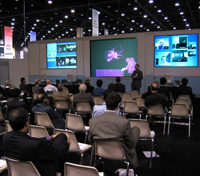RSNA Doctors See Potential for 3D Medical Training
December 10th, 2003 - December 17th, 2003
Categories: Devices, Networking

About
Groups of otherwise well-dressed doctors and medical technologists were seen sporting paper stereo glasses at the 89th Scientific Assembly and Annual Meeting of the Radiological Society of North America (RSNA) in Chicago, November 30-December 5.
The glasses, perhaps more commonplace in a science fiction convention than an assembly of radiologists, permitted attendees to view stereo red / blue anaglyphic animations of medical volume visualization data. The animations were streamed from an ImmersaDesk at the University of Chicago campus over the Abilene network to the McCormick Place conference show floor using TeraVision, a scalable, high-resolution graphics streaming system developed at University of Illinois at Chicago’s Electronic Visualization Laboratory (EVL).
In a University of Chicago demonstration, RSNA attendees viewed a projected 3D model of a patient’s abdominal vasculature generated by MRI data. A few miles away on the University of Chicago campus, Fred Dech, a visualization expert in the Department of Surgery, rotated and sliced the model to reveal and isolate certain structures, while his colleague, Dr. Jonathan Silverstein, described the collaborative application to the audience.
Using the enhanced capabilities of Grid computing, we’re building applications to improve patient safety and academic efficiency in biomedicine by bringing teams together virtually to share their observations, said Silverstein, an assistant professor in University of Chicago’s Department of Surgery. We’ve shown that complex three-dimensional anatomy can be better understood using stereo interactive displays than traditional teaching methods.
Both TeraVision and Dech’s medical volume visualization application employed EVL-developed networking software Quanta and virtual-reality graphics library CAVELib to support the tele-immersive networked session and apply the red / blue coding to the data.
TeraVision, unlike standard video streaming systems, is capable of transferring uncompressed high-resolution visualizations over advanced networks. Compression algorithms are commonly applied to high-resolution image transfers to make them compact enough to transmit over low bandwidth or highly congested networks.
Standard compression often introduces artifacts or distortions that could prove disastrous in a medical context if misinterpreted by a remote colleague, said EVL associate professor Jason Leigh. In a collaborative application domain like medical visualization, TeraVision is an ideal tool for streaming such compression-sensitive data.
TeraVision can stream video between a wide range of computer platforms at gigabit-per-second speeds without requiring any modifications to the visualization application or slowing it down, said EVL doctoral student and TeraVision developer Rajvikram Singh.
An Access Grid session running concurrent with the demonstration allowed remote audience participation from InSors in Chicago, Internet2 in Ann Arbor, and National Library of Medicine’s High Performance Computing and Communications office in Bethesda. The Access Grid is an advanced, distributed videoconferencing system anchored at Argonne National Laboratory.
The annual RSNA conference promotes the latest research and development discoveries, including radiological data visualization systems connected by high-performance networks.
The University of Chicago-developed application is funded in part by National Institutes of Health / National Library of Medicine. The Electronic Visualization Laboratory at the University of Illinois at Chicago’s networking and instrumentation research is funded by the National Science Foundation. The ImmersaDesk, CAVELib and Quanta are registered trademarks of the Board of Trustees of the University of Illinois.